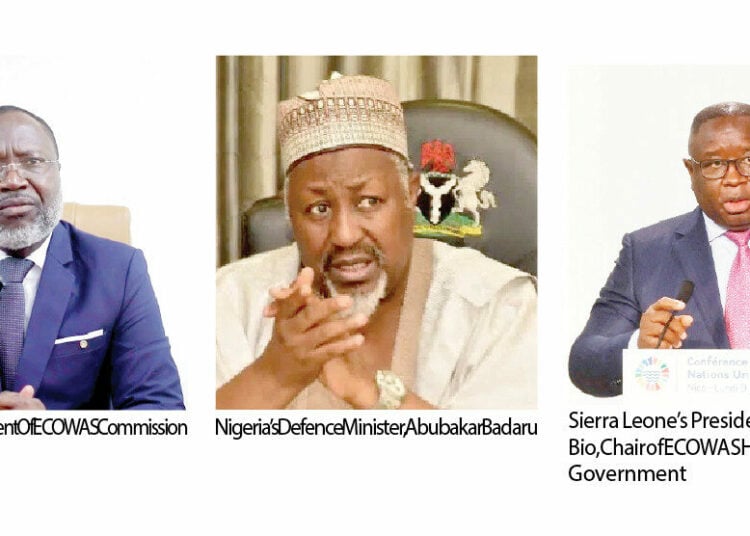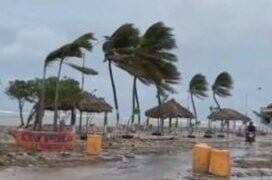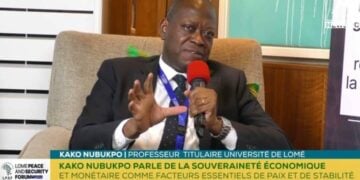The increasing threats of terrorism and violent extremism in West Africa have necessitated a multi-faceted approach by regional leaders and experts on the most viable way to fund the efforts to tackle the scourges which have continued to destroy lives and property, hindering trade and investments.
President of the ECOWAS Commission, Dr. Omar Touray, was emphatic about the threat of terrorism in the region when he quoted data from The Global Terrorism Index (GTI) 2025, which revealed a significant shift in global terrorism patterns, with Africa emerging as the new epicenter of terrorist activities. The Sahel region, in particular, has seen a dramatic increase in terrorist operations, driven by political instability, weak governance, and ongoing conflicts. The data noted that this shift marks a notable change from previous years, where the Middle East was the primary region affected by terrorism.
During the meeting of the Finance and Defence Ministers of the sub region on the modalities for funds mobilisation for the activation of a regional force to fight terrorism held in Abuja on Friday, August 29, several proposals were raised as to the best approach for the funding mechanism against terrorism and unconstitutional change of government in the region.
The challenge of funding has always been the main stumbling block to the efforts to dislodge terrorists and their backers in the region. Recall that on June 27, 2024, the regional ministers met in Abuja and considered the activation of the regional standby force to fight against terrorism and unconstitutional change of government in the ECOWAS region.
Two options examined for the birth of the ECOWAS Standby Force (ESF) were: – A Force of 5,000-man brigade for deployment to restore sanity and order wherever security and peace are threatened in the ECOWAS region. The overall estimated cost for this size of the Brigade stood at about US$ 2.61billion for the first year of taking off.
The second option was a force of 1,650-Man Brigade by adopting a step-by-step approach towards the 5,000-Man Brigade target. The estimated cost for this option came out as US$ 481.5million.
At the end of those deliberations, the ministers issued a directive to carry out an impact assessment of the increase of the community levy on the economy of Member States and the cost-effectiveness of the options.
Therefore Friday’s session was an opportunity to present the findings from a team of consultants deployed to Member States to carry out the exercise, which will give a clearer picture of things based on the data collected from respective countries, which will enable stakeholders to make informed decisions.
At the time of writing this piece, the finding has not been presented but the stakeholders hold the view that a coordinated approach to increased funding has become essential in the fight to end the menace of terrorism.
Part of the deliberation were whether the funding structure should take the form of adjustment of the Community Levy, recovery of the Community Levy arrears, GDP-based contributions, direct budgetary allocations, blended financing, or targeted partnerships.
As much as each approach has been designed to support scalability, accountability, and measurable outcomes, generating the funds in sufficient measures through these could pose a real challenge. For instance on the issue of Community Levy, many countries of the region are not up to date and the backlog of arrears has continued to mount. It has not been easy to get these countries to remit the appropriate levy and the sanctions against defaulters have been feeble.
It remains to be seen how the region can get funds from a GDP-based contribution without some discrepancies. Sourcing funds from a GDP-based contribution is generally done by increasing a country’s tax-to-GDP ratio, which directly links government revenue to the size of the economy. This will make countries with larger economies pay more and might lead to imbalance.
The budgetary allocation formula may run into some difficulty if the modalities are not properly sorted out about the required threshold for member countries. It has therefore become imperative that the region moves fast to address this growing threat as the terrorists seem to be taking over territories in parts of the region,
This was emphasized by Touray in his remarks, which makes it mandatory for leaders to immediately deploy a multi-faceted approach and structure of resource mobilization that is predictable and reflects the necessities of the current times.
“Faced with the reality of terrorism as a phenomenon in the ECOWAS region, the regional body has been actively engaged in counter-terrorism efforts, deploying a multi-faceted approach. The approach covers developing a comprehensive Counter-Terrorism Strategy and Implementation Plan, establishing a Standby Force, and fostering regional cooperation on intelligence sharing, training, and humanitarian interventions,” Touray said.
Nigeria’s Minister of Defence, Abubakar Badaru , who restated Nigeria’s commitment, was of the view that Friday’s meeting was a critical step forward in the shared commitment to activate a regional counterterrorism force, a mechanism that embodies regional resolve to safeguard sovereignty, uphold constitutional order, and protect the lives and livelihood of our citizens.
Col Brima Muana Massaquoi, deputy Minister of Defence of Sierra Leone, echoed the same sentiments, saying, “In as much as the financial experts would come up with a comprehensive and workable funds mobilisation scheme, let us be reminded that we need to explore diverse, inclusive and innovative funding mechanisms.
“These may include but are not limited to leveraging on pledges from Member States, Regional Financial Institutions, establishing Specialised Regional Security Funds and engaging our international partners for Finance and Technical Assistance.”





